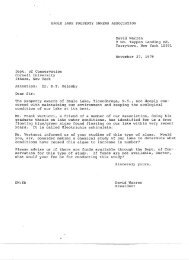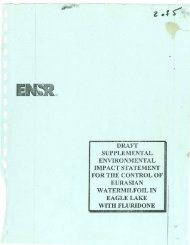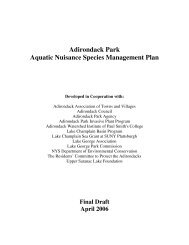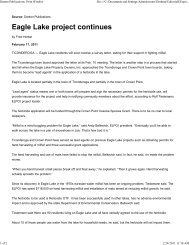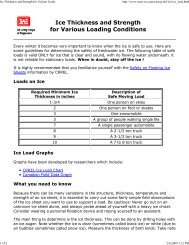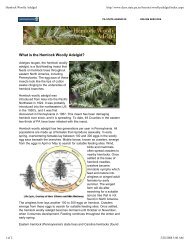Maine Field Guide to Invasive Aquatic Plants - Brant Lake Milfoil ...
Maine Field Guide to Invasive Aquatic Plants - Brant Lake Milfoil ...
Maine Field Guide to Invasive Aquatic Plants - Brant Lake Milfoil ...
Create successful ePaper yourself
Turn your PDF publications into a flip-book with our unique Google optimized e-Paper software.
VARIABLE WATER-MILFOIL<br />
Myriophyllum heterophyllum<br />
NOT NATIVE TO MAINE - INVASIVE<br />
I N V A S I V E P L A N T S<br />
NOTE: All leafy milfoils display a wide range of vegetative<br />
variability. Any milfoil found in <strong>Maine</strong> waters should be considered<br />
“suspicious” until a positive identification has been confirmed by<br />
someone with the appropriate expertise.<br />
Habitat: Variable water-milfoil is<br />
an extremely well adapted plant,<br />
able <strong>to</strong> thrive in a wide variety of<br />
environmental conditions. It<br />
grows well in still and flowing<br />
waters, and can survive under ice.<br />
Variable water-milfoil grows<br />
rooted in water depths from 1 <strong>to</strong><br />
5 meters on various substrates<br />
Terrestrial morphs<br />
including organic muck, silt, sand<br />
and gravel. <strong>Plants</strong> stranded on dewatered shorelines form erect spikes<br />
known as “terrestrial morphs.” The morphs, resembling miniature pine<br />
trees, will remain in this land-adapted form until the waters return, at<br />
which time they will “morph” back in<strong>to</strong> submersed aquatic plants.<br />
Description: Variable water-milfoil is a<br />
submersed, aquatic plant with branching stems<br />
emerging from dense, spreading roots. Featherdivided<br />
leaves are arranged in densely packed<br />
whorls. (Leaves along lower portions of the stem<br />
may not be in perfect<br />
emergent flower<br />
spike<br />
water surface<br />
submersed<br />
stem<br />
Variable water-milfoil<br />
(Myriophyllum heterophyllum)<br />
whorls, i.e., some<br />
leaves may be slightly<br />
offset.) There are<br />
generally 4 <strong>to</strong> 6<br />
leaves per whorl and<br />
Stem cross-section showing<br />
whorl of 6 leaves<br />
5 <strong>to</strong> 14 pairs of thread-like leaflets on each<br />
leaf. The dense leaf arrangement gives this<br />
plant a bottle brush appearance. Stems may<br />
be green and slight, but most often they are<br />
thick, robust and reddish in color (even<br />
bright red). Flowers and bracts are<br />
arranged in whorls on an emergent flower<br />
spike. The tiny white flowers occur in the<br />
axils of the bracts. The bracts are bladeshaped,<br />
serrated, and more than twice the<br />
length of the flower. Winter buds (or turions)<br />
are formed in the fall at the base of the<br />
stems or on the rhizomes.<br />
30 <strong>Maine</strong> Volunteer <strong>Lake</strong> Moni<strong>to</strong>ring Program



